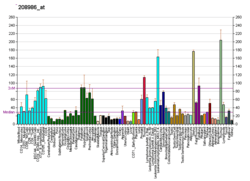TCF12
Transcription factor 12 is a protein that in humans is encoded by the TCF12 gene.[5][6]
The protein encoded by this gene is a member of the basic helix-loop-helix (bHLH) E-protein family that recognizes the consensus binding site (E-box) CANNTG. This encoded protein is expressed in many tissues, among them skeletal muscle, thymus, B- and T-cells, and may participate in regulating lineage-specific gene expression through the formation of heterodimers with other bHLH E-proteins. Several alternatively spliced transcript variants of this gene have been described, but the full-length nature of some of these variants has not been determined.[6] TCF12 has been speculatively related to human male sexuality through a GWAS study indicating association to a related single nucleotide polymorphism.[7] Mutations in this gene have also been associated with cases of coronal craniosynostosis.[8]
TCF12 is the primary heterodimerising partner of TCF21, a tumour suppressor gene and a target of SRY/SOX9 activity.[9]
References
- GRCh38: Ensembl release 89: ENSG00000140262 - Ensembl, May 2017
- GRCm38: Ensembl release 89: ENSMUSG00000032228 - Ensembl, May 2017
- "Human PubMed Reference:". National Center for Biotechnology Information, U.S. National Library of Medicine.
- "Mouse PubMed Reference:". National Center for Biotechnology Information, U.S. National Library of Medicine.
- Zhang Y, Babin J, Feldhaus AL, Singh H, Sharp PA, Bina M (August 1991). "HTF4: a new human helix-loop-helix protein". Nucleic Acids Research. 19 (16): 4555. doi:10.1093/nar/19.16.4555. PMC 328652. PMID 1886779.
- "Entrez Gene: TCF12 transcription factor 12 (HTF4, helix-loop-helix transcription factors 4)".
- Ganna A, Verweij KJ, Nivard MG, Maier R, Wedow R, Busch AS, et al. (August 2019). "Large-scale GWAS reveals insights into the genetic architecture of same-sex sexual behavior". Science. 365 (6456): eaat7693. doi:10.1126/science.aat7693. PMC 7082777. PMID 31467194.
- Sharma VP, Fenwick AL, Brockop MS, McGowan SJ, Goos JA, Hoogeboom AJ, et al. (March 2013). "Mutations in TCF12, encoding a basic helix-loop-helix partner of TWIST1, are a frequent cause of coronal craniosynostosis". Nature Genetics. 45 (3): 304–7. doi:10.1038/ng.2531. PMC 3647333. PMID 23354436.
- Bhandari RK, Sadler-Riggleman I, Clement TM, Skinner MK (2011-05-17). "Basic helix-loop-helix transcription factor TCF21 is a downstream target of the male sex determining gene SRY". PLOS ONE. 6 (5): e19935. Bibcode:2011PLoSO...619935B. doi:10.1371/journal.pone.0019935. PMC 3101584. PMID 21637323.
Further reading
- Bain G, Murre C (April 1998). "The role of E-proteins in B- and T-lymphocyte development". Seminars in Immunology. 10 (2): 143–53. doi:10.1006/smim.1998.0116. PMID 9618760.
- Hu JS, Olson EN, Kingston RE (March 1992). "HEB, a helix-loop-helix protein related to E2A and ITF2 that can modulate the DNA-binding ability of myogenic regulatory factors". Molecular and Cellular Biology. 12 (3): 1031–42. doi:10.1128/MCB.12.3.1031. PMC 369535. PMID 1312219.
- Zhang Y, Bina M (1992). "The nucleotide sequence of the human transcription factor HTF4a cDNA". DNA Sequence. 2 (6): 397–403. doi:10.3109/10425179209020819. PMID 1446075.
- Zhang Y, Doyle K, Bina M (September 1992). "Interactions of HTF4 with E-box motifs in the long terminal repeat of human immunodeficiency virus type 1". Journal of Virology. 66 (9): 5631–4. doi:10.1128/JVI.66.9.5631-5634.1992. PMC 289128. PMID 1501295.
- Sommer L, Hagenbüchle O, Wellauer PK, Strubin M (November 1991). "Nuclear targeting of the transcription factor PTF1 is mediated by a protein subunit that does not bind to the PTF1 cognate sequence". Cell. 67 (5): 987–94. doi:10.1016/0092-8674(91)90371-5. PMID 1720355.
- Zhang Y, Flejter WL, Barcroft CL, Rivière M, Szpirer J, Szpirer C, Bina M (1995). "Localization of the human HTF4 transcription factors 4 gene (TCF12) to chromosome 15q21". Cytogenetics and Cell Genetics. 68 (3–4): 235–8. doi:10.1159/000133921. PMID 7842744.
- Doyle K, Zhang Y, Baer R, Bina M (April 1994). "Distinguishable patterns of protein-DNA interactions involving complexes of basic helix-loop-helix proteins". The Journal of Biological Chemistry. 269 (16): 12099–105. PMID 8163514.
- Langlands K, Yin X, Anand G, Prochownik EV (August 1997). "Differential interactions of Id proteins with basic-helix-loop-helix transcription factors". The Journal of Biological Chemistry. 272 (32): 19785–93. doi:10.1074/jbc.272.32.19785. PMID 9242638.
- Goldfarb AN, Lewandowska K, Pennell CA (January 1998). "Identification of a highly conserved module in E proteins required for in vivo helix-loop-helix dimerization". The Journal of Biological Chemistry. 273 (5): 2866–73. doi:10.1074/jbc.273.5.2866. PMID 9446597.
- Massari ME, Rivera RR, Voland JR, Quong MW, Breit TM, van Dongen JJ, et al. (June 1998). "Characterization of ABF-1, a novel basic helix-loop-helix transcription factor expressed in activated B lymphocytes". Molecular and Cellular Biology. 18 (6): 3130–9. doi:10.1128/mcb.18.6.3130. PMC 108895. PMID 9584154.
- Adell T, Gómez-Cuadrado A, Skoudy A, Pettengill OS, Longnecker DS, Real FX (March 2000). "Role of the basic helix-loop-helix transcription factor p48 in the differentiation phenotype of exocrine pancreas cancer cells". Cell Growth & Differentiation. 11 (3): 137–47. PMID 10768861.
- Hartley JL, Temple GF, Brasch MA (November 2000). "DNA cloning using in vitro site-specific recombination". Genome Research. 10 (11): 1788–95. doi:10.1101/gr.143000. PMC 310948. PMID 11076863.
- Wiemann S, Weil B, Wellenreuther R, Gassenhuber J, Glassl S, Ansorge W, et al. (March 2001). "Toward a catalog of human genes and proteins: sequencing and analysis of 500 novel complete protein coding human cDNAs". Genome Research. 11 (3): 422–35. doi:10.1101/gr.GR1547R. PMC 311072. PMID 11230166.
- Simpson JC, Wellenreuther R, Poustka A, Pepperkok R, Wiemann S (September 2000). "Systematic subcellular localization of novel proteins identified by large-scale cDNA sequencing". EMBO Reports. 1 (3): 287–92. doi:10.1093/embo-reports/kvd058. PMC 1083732. PMID 11256614.
- Mandolesi G, Gargano S, Pennuto M, Illi B, Molfetta R, Soucek L, et al. (January 2002). "NGF-dependent and tissue-specific transcription of vgf is regulated by a CREB-p300 and bHLH factor interaction". FEBS Letters. 510 (1–2): 50–6. doi:10.1016/S0014-5793(01)03227-6. PMID 11755530.
- Knöfler M, Meinhardt G, Bauer S, Loregger T, Vasicek R, Bloor DJ, et al. (February 2002). "Human Hand1 basic helix-loop-helix (bHLH) protein: extra-embryonic expression pattern, interaction partners and identification of its transcriptional repressor domains". The Biochemical Journal. 361 (Pt 3): 641–51. doi:10.1042/0264-6021:3610641. PMC 1222348. PMID 11802795.
- Tremblay M, Herblot S, Lecuyer E, Hoang T (April 2003). "Regulation of pT alpha gene expression by a dosage of E2A, HEB, and SCL". The Journal of Biological Chemistry. 278 (15): 12680–7. doi:10.1074/jbc.M209870200. PMID 12566462.




